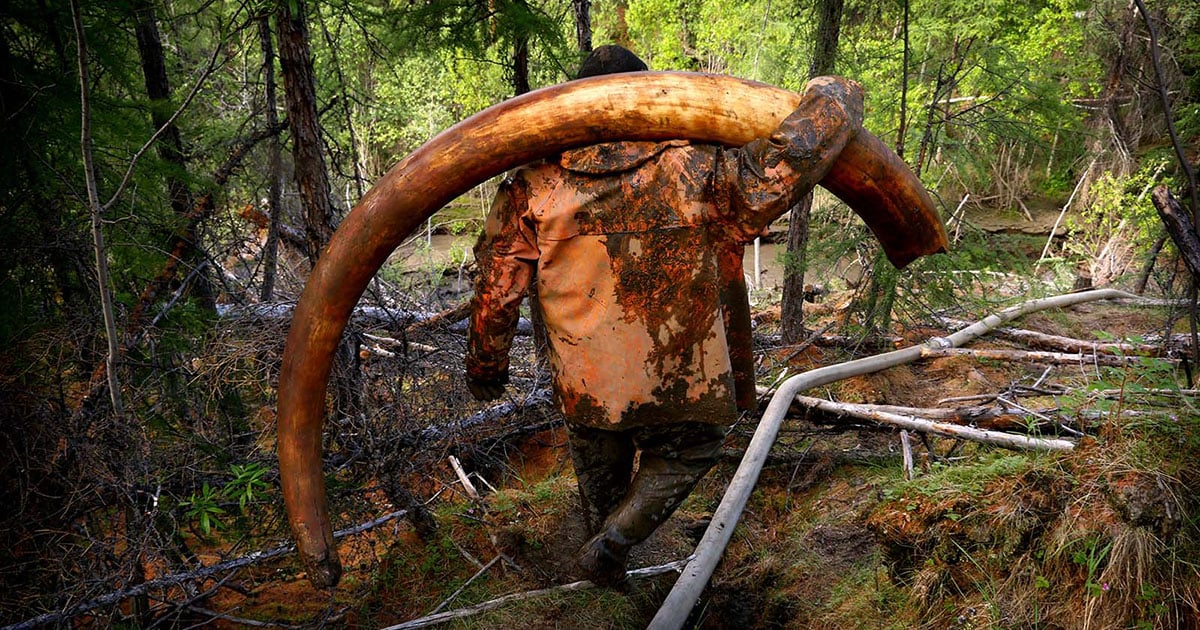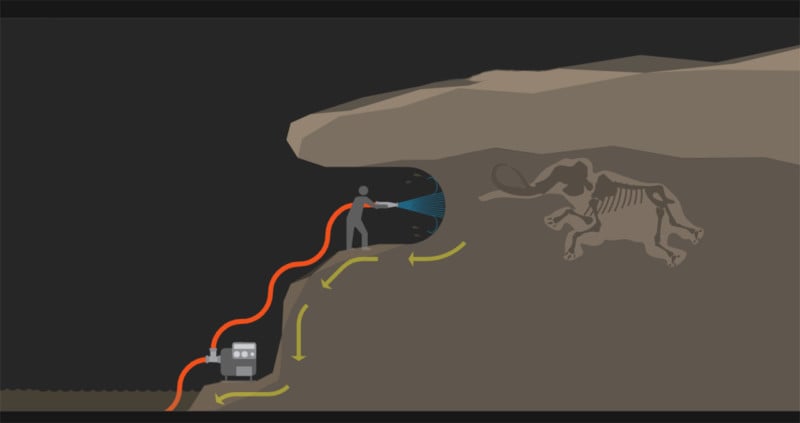Climate change has damaged precious cultural resources and altered conditions at many sites, changing how archaeologists approach sites in the modern day and will in the future.
Threats to Archaeological Sites
In most cases, climate change has considerable negative impacts on archaeological sites, destroying or damaging important contexts which provide crucial information about our cultural resources. Although the degradation of sites will always occur naturally from environmental conditions, climate change accelerates this greatly. Below are some of the factors resulting from climate change that have affected the stability and maintenance of sites:
- Melting permafrost:
In places like the Arctic, permafrost and ice has helped preserve many artifacts for centuries by halting biological and chemical decay. However, global warming has thawed the permafrost and glaciers in these cold environments, leading to artifacts and remains, often made of organic material like wood, bone, or ivory, to be exposed to oxygen suddenly and degrade quickly./https://tf-cmsv2-smithsonianmag-media.s3.amazonaws.com/filer_public/de/52/de526958-55af-4faf-8b79-5b58b958e09a/iceman_web.jpg)
“Ötzi the Iceman”, 5300 year-old, extremely well-preserved mummy thanks to the freezing conditions of the Ötztal Alps he was discovered in. Image source. The Arctic, which is very archaeologically-rich and has been determined by experts worldwide to contain over 180,000 archaeological sites, is especially at risk as temperatures there are rising much faster than the global average. In Southern Greenland, archaeologists excavating a region where the first Norwegian explorers founded the first European settlement on the island are already experiencing the impacts of rising temperatures, as well-preserved artifacts become increasingly rare and most recovered are in a state of advanced or complete degradation.
Beyond negative impacts for archaeologists, the melting ice exposes valuable artifacts to looters and thieves. In some cases, like in northeastern Siberia, ivory hunters have set up camps near sites where woolly mammoths have melted out of the permafrost, using high-pressure water pumps to remove their ivory tusks to then sell on the black market.

“Mammoth Pirates” in Siberia steal valuable ivory tusks. Image Source. 
Diagram of how Mammoth Pirates steal ivory tusks using high-pressure water pumps. Image Source. - Rising temperatures:
As global temperatures rise, this impacts the soil conditions where artifacts are buried, including increasing soil temperatures and decreasing soil moisture from evaporation. Increased soil temperatures accelerate the rate of decay of artifacts, especially those that are made of organic materials, while less humid soil make sites more prone to damage from wind, water erosion, drought, and wildfires. In addition, fluctuations in temperature can lead to the expansion and contraction of artifacts made from mineral, causing micro-cracking and erosion on the surface of stone structures.
The Adam Spach House in North Carolina which dates back to the 18th century. Increased temperatures in the past few years have led to overgrowth from moss and other plants. Image Source. - Erosion:
Erosion, especially coastal erosions, has become a major challenge as sea levels increase, precipitation becomes more frequent, and natural disasters increase. Coastal erosion has been particularly harmful as there are an estimated millions of archaeological sites located in coastal areas, and a mere 1-meter rise in sea level is calculated to cause more than 13,000 sites to be lost. This is both a gradual and sudden occurrence. In 2005, a large portion of a prehistoric settlement on the Western Isles of Scotland collapsed when the coastline retreated around 50 meters overnight, destroying structures, exposing archaeological deposits, and scattering cultural material across the coast.
Kisimul Castle, one of the archaeological sites located on the coast of the Western Isles in Scotland. Image Source. Apart from its more noticeable effects, erosion can also erase or alter the context of sites which offer valuable information to archaeologists by shifting artifacts, disrupting soil layers, or exposing artifacts to the elements.
Soil profile of non-eroded sample (A) and eroded sample (B). Image Source. - Extreme weather:
Hurricanes, droughts, floods, heatwaves, wildfires, and other natural disasters which have proliferated and intensified due to climate change continue to destroy and endanger archaeological sites globally. Hurricanes bring heavy wind, rain, and storm surges, devastating any archaeological sites in its path, even including those underwater. Felled trees disturb archaeological sites, flooding causes mold growth and displaces soil & artifacts, shorelines erode into the ocean, and wave energy fractures exposed structures.Tree uprooted during Hurricanes Florence and Michael in 2008 unearths and disturbs historical sites and structures in North Carolina. Image Source. Droughts and heatwaves decrease moisture content in soil and evaporate bodies of water, exposing submerged sites and making artifacts and structures prone to breakage. Dryer landscapes also favor wildfires, which ravage exposed and buried structures and even alter stronger artifacts made of glass or metal. In 2021, wildfires in Greece came dangerously close to the ancient site of Olympia, leading to evacuations and desperate efforts to save the site. Fortunately, the fire was extinguished, but this event was a testament to just how large the scale of climate change’s effects on archaeology were.
Wildfires in Greece. Image Source. Finally, extreme cold conditions from winter storms, snow, and ice can degrade artifacts as they freeze. As artifacts are put through cycles of freezing and thawing, water expands when it freezes, then artifacts disintegrate when this ice melts. Snow and ice can also place stress on archaeological structures and cause them to collapse.
- Change in oceanic conditions:The full extent of underwater archaeological sites remains unknown, but thousands of shipwrecks, as well as submerged cities, ports, and ancient settlements in recent years, leading archaeologists to suspect multitudes remain undiscovered, but increased water acidity and water levels as a result of changing oceanic conditions has threatened these sites. Sea level rises and thermal expansion impact the depth of sites that were once in shallower water, changing surrounding conditions like pressure and ocean currents. In addition, as sea level rises, saltwater intrusion into freshwater systems becomes more common. This can be detrimental to underwater sites in these freshwater systems by causing substantial corrosion of iron.In oceans, saltier water, higher acidity, and warmer temperatures levels increases corrosion of metal components in sites, collapsing site structures. Warmer temperatures also support common shipworms and larger fish, which can cause damage to underwater wooden structures.
Responses to Climate Change
Climate change has intensified the need for quick and efficient “rescue” excavations, where archaeology had previously emphasized meticulous and slow preservation, with some excavations regularly taking years to complete. However, with climate change worsening and threatening to destroy more and more important cultural resources, archaeologists must act fast in order to preserve the valuable context and artifacts that are at risk of fading away completely.
As the field continues to change in response to modern problems, archaeologists must face the difficult questions: Given our current window of time to preserve rapidly deteriorating cultural resources, should current preservation techniques be reorganized to favor speed, potentially sacrificing quality and detail? What sites are possible to save? What sites are worth saving? What steps can take to address these issues?
Climate change is erasing traces of our shared past, yet its devastating impact on archaeology is too often overlooked. As ancient sites and the human stories they hold disappear, we must urge policymakers and communities alike to recognize and protect this endangered record of humanity.
Works Cited:
- Ellis, L. (2019, December 11). How climate change affects archaeology. https://medium.com/@lindaellisphd/how-climate-change-affects-archaeology-aca03fc3f840
- Anderson, D. G., Bissett, T. G., Yerka, S. J., Wells, J. J., Kansa, E. C., Kansa, S. W., Myers, K. N., DeMuth, R. C., & White, D. A. (2017). Sea-level rise and archaeological site destruction: An example from the southeastern United States using DINAA (Digital Index of North American Archaeology). https://journals.plos.org/plosone/article?id=10.1371/journal.pone.0188142
- UNESCO Courier. (n.d.). The impact of climate change on archaeological sites. https://courier.unesco.org/en/articles/impact-climate-change-archaeological-sites
- North Carolina Department of Natural and Cultural Resources. (2023, June 1). Heritage at risk: Submerged sites. https://archaeology.ncdcr.gov/blog/20230601/heritageatrisksubmergedsites
- Phillips, J. D., & Van De Noort, R. (2020). Climate change and archaeology: Challenges for the 21st century. WIREs Climate Change. https://wires.onlinelibrary.wiley.com/doi/10.1002/wcc.710
- Torres, R., & Pacheco, J. (2024). Rising seas, eroding history: Coastal heritage loss under climate change. Marine Pollution Bulletin. https://www.sciencedirect.com/science/article/abs/pii/S0025326X24014371


